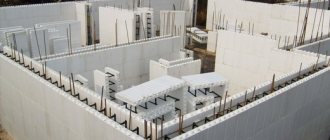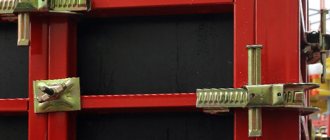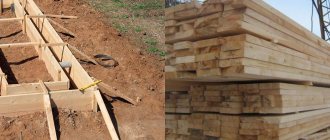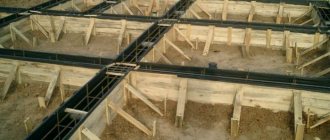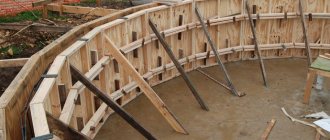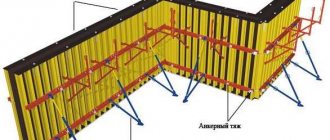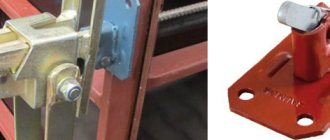The difficulties that were encountered during the installation and dismantling of formwork structures were left far behind when special locks for formwork were invented, giving a certain comfort to working with its components. In certain situations, for example, when constructing large monolithic structures, such locking mechanisms are indispensable devices that make work easier and reduce labor costs.
Need for use
Locks for fastening formwork give connections reliability and strength.
Their main purpose is to hold the necessary shapes of the structure into which the concrete solution is poured.
In addition, with the help of locks, the panels of formwork systems are tightly connected to each other and can withstand significant loads created by the concrete mass. The concreting process is simplified, working time and even financial resources are saved.
Wedge and universal locks for fastening formwork sheets
When installing fences, due attention is paid to the fastening mechanisms, as they ensure the stability and reliability of the frame for pouring concrete. This eliminates the appearance of cracks by tightly connecting the panel elements to each other. The most common and practical are formwork locks, but they are classified according to type.
Purpose
The main purpose of using universal, spring, wedge varieties is to maintain the appropriate shape so that the concrete mixture is poured and hardens according to the dimensions selected by the project. They also allow the panels to be tightly fixed to each other and withstand heavy loads and pressure exerted by concrete. Locks are used for the manufacture of frames for any purpose:
- Stenovykh.
- Fundamental.
- Columned.
- Floor slabs and coverings, crossbars.
The cost of the parts is relatively low, and their installation does not require much labor. Due to the simple design, only hammers or wrenches are used. The resistance arising from the fastenings is capable of holding the structure in a given position and resisting tensile and compressive loads.
The formwork form is assembled without the formation of cracks, thereby eliminating the appearance of defects in the joints. Installation and dismantling is carried out as quickly and easily as possible, so construction time is saved. After pouring the concrete, it is compacted; the fasteners, in turn, are resistant to dynamic loads. Then they will not be able to slide off the shield frame during vibration, if contact with paint or concrete mortar is excluded.
Types of castles
Products are divided into several varieties:
- Universal.
- Screw.
- Spring.
- Wedges.
- Drums.
- Chiroses.
1. Universal.
Also called extended, as it can be installed with additional parts up to 25 cm wide. The product allows you to connect panels in the same plane or at a right angle. Practical for any fence and has some advantages: reliable fixation of the walls, ease of installation, suitable for corner areas of a rigid or hinged type.
Rack and leveling locks are capable of not only tightly fastening panels, but also leveling them. Often the scope of application is limited to monolithic construction, which requires the installation of a large panel frame. The most common, its products can be purchased at an affordable price if they are not included with the formwork structure.
2. Wedge.
The mechanism connects the panels in the horizontal and vertical directions and then aligns them. According to the material, they are distinguished into galvanized and cast iron, and according to the design - ordinary and rack. When used, the strength and rigidity of the formwork is ensured, as well as a perfectly flat concrete surface.
Wedge locks of the most budget option are called “crabs”, the weight of which does not exceed 3 kg. Manufactured using precision casting, they are therefore safe and reliable to use.
3. Spring.
This option is practical for panel formwork made of wood or metal. It is a clamp that is installed and secured using a special key. Installation is carried out quickly without additional tools, and is very convenient when installing fences of varying complexity. The cost of such products is low. Capable of withstanding forces from concrete mortar up to 2000 kg, while there are reinforced options where the resistance is much higher.
4. Screw.
A fairly common type, which structurally consists of a screw and nut attached to the reinforcement. Its weight is 4.5-5 kg, and an additional element up to 250 mm wide is used.
5. Percussion.
Most effective for creating small panel formwork. Like the wedge one, it is as easy as possible to install. To ensure a tight connection between the panels, it is necessary to install the locks using a hammer. The process does not take much time, and is suitable for walls of different sizes and materials.
6. Chiroses.
This is a reinforcing element that consists of a spring clamp and a support sole. The clamp has gained popularity in monolithic construction; “frogs” are suitable for forming columns, strip bases, staircases, and walls. Locks are used for fittings with a diameter of 6-10 mm, and before purchasing you should look at the quality of the ratchet mechanism. He is responsible for the reliability and strength of the entire structure.
Author: Valentin Tokarev
| Related articles: | |
| Application of PVC pipes for formwork assembly Where and how are tie bolts used for formwork structures? Guide to constructing formwork for concrete stairs | |
Areas of use
Using locks for panel formwork, frames for various purposes are installed:
- wall;
- foundation;
- columned;
- under the ceilings.
The cost of such elements is reasonable; installation does not require special skills. The device is simple; to install it, all you need is a hammer or a suitable size wrench.
Wedge castle
Most often, in order to give the assembled system the necessary strength, wedge locks for formwork are used - elements with which panel sets are assembled and leveled. When installed properly, the lock gives the joint areas density and the ability to withstand load forces, which allows you to pour smooth and even reinforced concrete structures.
The standard version of a wedge lock for formwork consists of steel jaws and a cast iron wedge. This combination makes it possible to create a reliable fastening point that can withstand loads and can be used many times in the future.
To fix the universal wedge lock on the joining sections of the formwork panels, a wedge is driven into the hole made in the jaws. As soon as the clamp is fully seated, the jaws are compressed in the profile channel and the formwork system is given additional rigidity. Using a settling wedge, panel elements are trimmed and tied together.
If the wedge mechanism is manufactured using technology, it is used for a long period, using it more than a dozen times.
Technically, the wedge lock is a non-separable device.
Main characteristics:
- the cost of one lock is from 400 rubles;
- the device is used on formwork made of iron or aluminum;
- element weight – 2.5 – 3.6 kg, sometimes its weight reaches 1 kg;
- galvanized locks or coated with powder paints perfectly withstand the effects of precipitation;
- The locks are easy to install, quickly dismantled, and conveniently stored.
Wedge locks are also distinguished by type of protection, focusing on their color shade:
- galvanized locks – silver-metallic color;
- a yellow tint indicates that this is an anodized element.
If the impact (wedge) lock intended for panel formwork is covered with paint, then its color can be blue, red or black.
Physical and technical features of formwork locks
Since formwork locks ensure the integrity of the entire structure, they are subject to high operational requirements. In their production, gray cast iron or steel is used. Both wedge, spring, screw and extended fasteners, as well as a universal lock for formwork, the price of which in our company will range from 980 to 1050 rubles/piece, are manufactured using casting technology. It provides the connecting unit with high strength and reliability.
When choosing a cast wedge lock or another type, pay attention to:
- production material - steel 35GL, cast iron and steel, gray cast iron;
- Part coatings - anodizing, powder painting, galvanizing. From us you can buy formwork locks at the manufacturer's price without coating. Their cost will be lower, but so will their service life;
- permissible insert thickness.
The formwork locks listed above, the price of which will range from 450 to 1050 rubles / piece, are used to fasten the panels of aluminum, steel, plastic and small-panel formwork systems. They are used on both horizontal and vertical connecting seams.
Universal lock
This fastening device is popularly called a “crocodile”. It is considered a subspecies of the previous connecting element. A universal formwork lock tightens steel and aluminum panels at the joints in a similar way, but is mainly used on a large panel system. As in the first design, the universal device consists of a wedge inserted into the hole of the upper lip. The difference lies in the type of second jaw and the method of placing the wedge itself. After entering the upper lip, the wedge is fixed on the ribs of the lower lip using a special groove.
Using a rack (universal) lock for assembling formwork, the thickness of the insert is easily and quickly adjusted; the connection is suitable for panels and panels of different sizes.
Universal or “extended” lock
This type of lock is also called “extended”. Universal locks are used to connect formwork panels, as well as to align them along the abutment plane. The difference between the lock and other types is the possibility of using an insert between panels up to 250mm wide. Also, a universal lock allows you to connect panels at right angles, which is especially convenient when constructing foundations. This lock is perfect for all types of formwork and has the following advantages:
- Any shields will be connected smoothly, tightly and coherently;
- The lock is easy to install even with one hand;
- Essential for internal, external and hinged corners.
Spring locking device
If it is necessary to erect a complex structure from a reinforced concrete monolith, various locks are used to assemble the formwork, including clamping devices called spring formwork locks.
The system is represented by reinforcement threaded through the panel element. Locks are put on the ends, one latches automatically, the second should be tightened to the required extent with the appropriate key. Once the fixation is complete, the protruding pieces of reinforcement are cut off. During dismantling work, only the locks are removed, and the reinforcing rod remains in its established place, being an integral part of the frozen monolith.
The spring-type lock is easy to use, simplified design, and reasonable price. Withstands loads reaching two tons, but there are also enhanced modifications.
What are spring locks for formwork?
When building a complex monolithic reinforced concrete structure, you will need various types of formwork locks, which you can buy at a low price from our company. Including special clamps, which are called spring fasteners. They consist of reinforcement that is threaded through the panels. Special locks are put on one end and the other. One latches automatically, and the other is tightened with a special key to the required degree. After fixing, the protruding edges of the reinforcement are cut off. Removing the clamps does not involve dismantling the fittings. It remains in a monolithic structure. Dealing with such a clamp will be more difficult than with the locks listed above.
In our company, all used formwork locks have a minimum price. We offer a wide range of high-quality products, for which we provide guarantees. If you have any difficulties choosing the type or volume of locking systems, call our manager. We will help you make the right choice.
Extended lock
This fastening option is a subtype of a screw connection. The elongated lock used for assembling the formwork is represented by an element equipped with a locking device with a thread, moving and stationary parts. The dimensions of the inserts reach twenty-five to thirty-five centimeters.
The lock is used for various formwork structures, but its main purpose is to fix a pair of panels at an angle of ninety degrees. And if a monolithic foundation is to be poured, experienced builders advise using this particular connection option.
The lock is made of steel and coated with a protective paint. There are also galvanized and anodized options, but their prices are significantly higher.
The advantages of an elongated lock are:
- giving the formwork system evenness, the ability to adjust the panels;
- ease and speed of assembly, not requiring special skills or special tools;
- used when joining hinge-type corner sections, as well as for external and internal corners.
Where to buy locks?
Some of the high-quality domestic manufacturers will offer you, if you call 8 495 213 9459, the organization supplies products not only to Russian, but also to foreign enterprises.
Completing equipment for formwork is also provided by PromStroyKontrakt, whose office is located in Moscow on the street. Obrucheva 13B. The company also has a convenient website where the client can familiarize himself with the assortment.
- Formwork.com - Moscow, st. Profsoyuznaya, 56
- M-Kontur - Moscow, st. Kedrova, 18
- Monolit-Stroy - 109457, Moscow, st. Zelenodolskaya, 36, building 1
- Industrialist - St. Petersburg, Leninsky Prospekt, 97, building 3
- Promstroysibir - 630108, Novosibirsk, st. Shirokaya, 1a
- Promstroykontrakt-Vostok - Kazan, st. Khalitova, 8
- Everything for monolithic housing construction - Krasnodar, st. Uralskaya, 85
- Formwork96 - Tyumen, st. Avtoremontnaya, 8
- STRONG Moscow, st. Stromynka, 13
Screw fastening
Using a formwork screw lock, insert elements measuring twenty to twenty-five centimeters are connected. This type of fastener is completed as follows - moving and stationary parts, a threaded section represented by a tightening screw and a nut securing it.
According to its purpose, the locking device performs the same functions as the universal fastening - it connects and aligns.
Made of steel, most often powder coated, it is easy to use and has a long service life. The main disadvantage is its significant weight, reaching up to five kilograms.
Types of castles
Different types of locks are used to connect the formwork. The choice depends on the dimensions of the shields and their weight; the type of material from which they are made is also taken into account. They can be wooden, metal or plastic. Manufacturers offer products, each of which differs in functionality and installation method:
- leveling lock for formwork;
- lock for end formwork;
- wedge crab castle
- screw lock;
- spring lock.
Installation
Metal formwork panels are fixed with locks in increments sufficient to give the entire structure the required strength, taking into account the pressure generated by the concrete solution being poured per square meter. To give the fastenings reliability, holes are drilled in the sheets for installing locking legs. In addition, the strength of the formwork system is increased by wooden beams installed at the points of interlocking joints along the entire length and width of the assembled structure.
With the help of such beams, the pressure from the lock is distributed, local deformation of metal sheets is eliminated.
As you know, fasteners are necessary for assembling any formwork structure, the features of which determine the installation process. The algorithm of actions is as follows:
- formwork panels are installed according to the design solution;
- their preliminary alignment is performed;
- locks are installed;
- After this, the system is finally leveled and firmly tightened.
Dismantling formwork locks
When using formwork systems in the construction of monolithic reinforced concrete structures, you should not only know the rules for their installation, but also carefully dismantle the structure in order to use it in further activities.
Dismantling work begins when the concrete mass has completely hardened and gained the required strength. First of all, the fastening locks are removed, for which the following steps are performed:
- in the wedge joint, knock out the wedge with a hammer and remove the lock jaws;
- if the connection was made with a spring lock, it is necessary to dismantle the clamping elements, leaving the reinforcement in the concrete and cutting off its protruding sections;
- in a screw connection, simply unscrew the nuts.
Having removed the fastening elements, they begin to carefully disassemble the panels in order to move them to a new area of work.
Dismantling
When using collapsible formwork structures in monolithic construction, it is necessary not only to correctly assemble, but also to correctly dismantle the structure. They begin dismantling when the concrete mixture hardens and acquires a sufficient level of strength. When dismantling the structure, first remove the fasteners, for this:
- when using wedge locks, it is necessary to knock out the wedge with a hammer and remove the jaws;
- To dismantle a joint secured with a spring lock, the clamps are first removed and the reinforcement remains in the hardened concrete. The protruding edges of the reinforcement are cut off with a grinder;
- To remove the screw lock, simply unscrew the nuts.
After removing the fasteners, you can begin dismantling the panels and moving the formwork to another location.
So, the main function of formwork locks is to fasten panels when assembling forms of a given configuration and size. The result directly depends on the quality of the fasteners and their proper installation, so you need to pay special attention to the choice of clamps. Locks used in modern construction are reliable, easy to install and dismantle.


